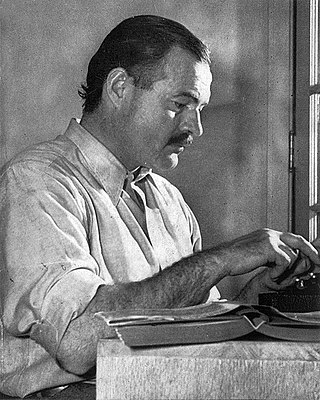
Ernest Miller Hemingway was an American novelist, short-story writer and journalist. Best known for an economical, understated style that significantly influenced later 20th-century writers, he is often romanticized for his adventurous lifestyle, and outspoken and blunt public image. Most of Hemingway's works were published between the mid-1920s and mid-1950s, including seven novels, six short-story collections and two non-fiction works. His writings have become classics of American literature; he was awarded the 1954 Nobel Prize in Literature, while three of his novels, four short-story collections and three nonfiction works were published posthumously.
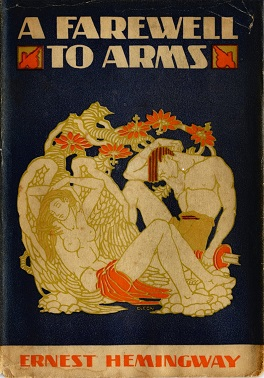
A Farewell to Arms is a novel by American writer Ernest Hemingway, set during the Italian campaign of World War I. First published in 1929, it is a first-person account of an American, Frederic Henry, serving as a lieutenant in the ambulance corps of the Italian Army. The novel describes a love affair between the American expatriate and an English nurse, Catherine Barkley.

A Moveable Feast is a 1964 memoir by American author Ernest Hemingway about his years as a struggling expatriate journalist and writer in Paris during the 1920s. It was published posthumously. The book details Hemingway's first marriage to Hadley Richardson and his associations with other cultural figures of the Lost Generation in Interwar France.

The Sun Also Rises is the first novel by the American writer Ernest Hemingway. It portrays American and British expatriates who travel along the Camino de Santiago from Paris to the Festival of San Fermín in Pamplona and watch the running of the bulls and the bullfights. An early modernist novel, it received mixed reviews upon publication. Hemingway biographer Jeffrey Meyers writes that it is now "recognized as Hemingway's greatest work" and Hemingway scholar Linda Wagner-Martin calls it his most important novel. The novel was published in the United States in October 1926 by Scribner's. A year later, Jonathan Cape published the novel in London under the title Fiesta. It remains in print.

Death in the Afternoon is a non-fiction book written by Ernest Hemingway about the history, ceremony and traditions of Spanish bullfighting, published in 1932. It also contains a deeper contemplation on the nature of fear and courage. While essentially a guide book, there are three main sections: Hemingway's work, pictures, and a glossary of terms.

Mariel Hemingway is an American actress. She began acting at age 14 with a Golden Globe-nominated breakout role in Lipstick (1976), and she received Academy and BAFTA Award nominations for her performance in Woody Allen's Manhattan (1979).

True at First Light is a book by American novelist Ernest Hemingway about his 1953–54 East African safari with his fourth wife Mary, released posthumously in his centennial year in 1999. The book received mostly negative or lukewarm reviews from the popular press and sparked a literary controversy regarding how, and whether, an author's work should be reworked and published after his death. Unlike critics in the popular press, Hemingway scholars generally consider True at First Light to be complex and a worthy addition to his canon of later fiction.

Across the River and Into the Trees is a novel by American writer Ernest Hemingway, published by Charles Scribner's Sons in 1950, after first being serialized in Cosmopolitan magazine earlier that year. The title is derived from the last words of U.S. Civil War Confederate General Thomas J. "Stonewall" Jackson: “Let us cross over the river and rest under the shade of the trees.”
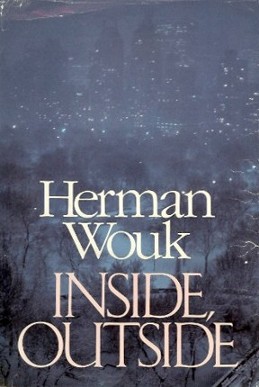
Inside, Outside is a 1985 Herman Wouk novel telling the story of four generations of a Russian Jewish family and its travails in Russia and America. The book is a first person narrative told from the viewpoint of Israel David Goodkind, the third of the four generations in the book. Goodkind works in a minor bureaucratic post in the White House between March and October 1973; his insignificance gives him time to write his memoirs while his position gives him opportunities to come face to face with the harried president Richard Nixon. Nixon never is named in the book, but there can be no doubt as to his identity. The narrative refers explicitly to the Watergate scandal, as an event contemporaneous with Goodkind's employment in the White House.
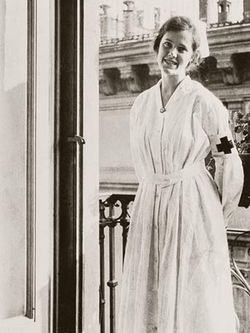
Agnes Hannah von Kurowsky Stanfield was an American nurse who inspired the character "Catherine Barkley" in Ernest Hemingway's 1929 novel A Farewell to Arms.

Elizabeth Hadley Richardson was the first wife of American author Ernest Hemingway. The two married in 1921 after a courtship of less than a year, and moved to Paris within months of being married. In Paris, Hemingway pursued a writing career, and through him Richardson met other expatriate American and British writers.

Pauline Marie Pfeiffer was an American journalist and the second wife of writer Ernest Hemingway.

Gloria Hemingway was an American physician and writer who was the third and youngest child of author Ernest Hemingway. Although she was born a male and lived most of her life publicly as a man, she struggled with her gender identity from a young age. In her 60s, she underwent gender transition surgery, and preferred the name Gloria when possible.

Hemingway's Adventures of a Young Man is a 1962 American adventure film directed by Martin Ritt based on Ernest Hemingway's semi-autobiographical character Nick Adams, and featuring Richard Beymer as Adams. A.E. Hotchner wrote the screenplay, originally calling the film Ernest Hemingway's "Young Man". The cast includes Diane Baker, Jessica Tandy, Ricardo Montalbán, Eli Wallach, Arthur Kennedy and Paul Newman. It was released in July 1962.

John Hadley Nicanor Hemingway was a Canadian-American fly fisherman, conservationist, and writer. He was the son of American novelist and Nobel Prize-laureate Ernest Hemingway.
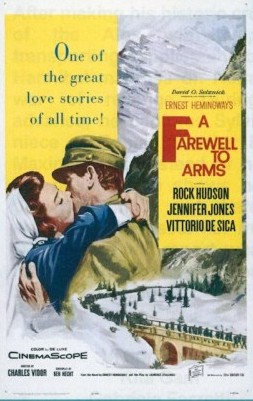
A Farewell to Arms is a 1957 American epic war drama film directed by Charles Vidor. The screenplay by Ben Hecht, based in part on a 1930 play by Laurence Stallings, was the second feature film adaptation of Ernest Hemingway's 1929 semi-autobiographical novel of the same name. It was the last film produced by David O. Selznick.

Patrick Miller Hemingway is an American wildlife manager and writer who is novelist Ernest Hemingway's second son, and the first born to Hemingway's second wife Pauline Pfeiffer. During his childhood he travelled frequently with his parents, and then attended Harvard University, graduated in 1950, and shortly thereafter moved to East Africa where he lived for 25 years. In Tanzania, Patrick was a professional big-game hunter and for over a decade he owned a safari business. In the 1960s he was appointed by the United Nations to the Wildlife Management College in Tanzania as a teacher of conservation and wildlife. In the 1970s he moved to Montana where he managed the intellectual property of his father's estate. He edited his father's unpublished novel about a 1950s safari to Africa and published it with the title True at First Light (1999).
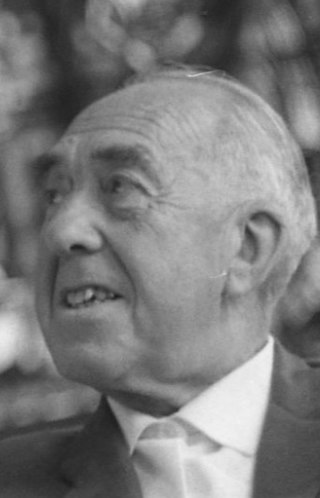
Juan Quintana Urra (1891-1974) was a Spanish hotelier, bullfight businessman, and activist in the Spanish Republic. He was the basis for the character Juanito Montoya in Ernest Hemingway's novel The Sun Also Rises.

Grace Ernestine Hemingway was an American opera singer, music teacher, and painter. She was Ernest Hemingway's mother.

The Ernest Hemingway Birthplace is a historic Queen Anne home and museum in Oak Park, Illinois, where American author Ernest Hemingway was born. Hemingway lived in the home with his family for the first six years of his life. The house was sold out of the Hemingway family in 1905, and it was subsequently renovated and converted into a multi-family residence.


















